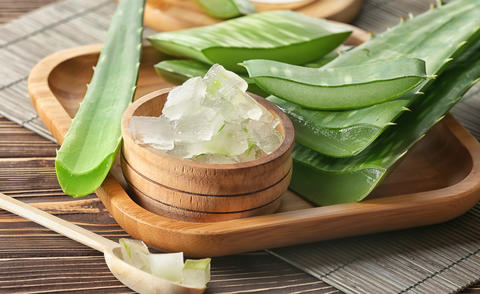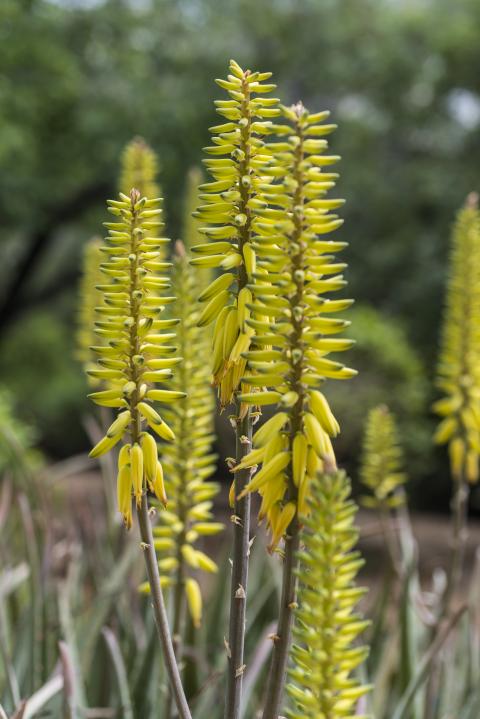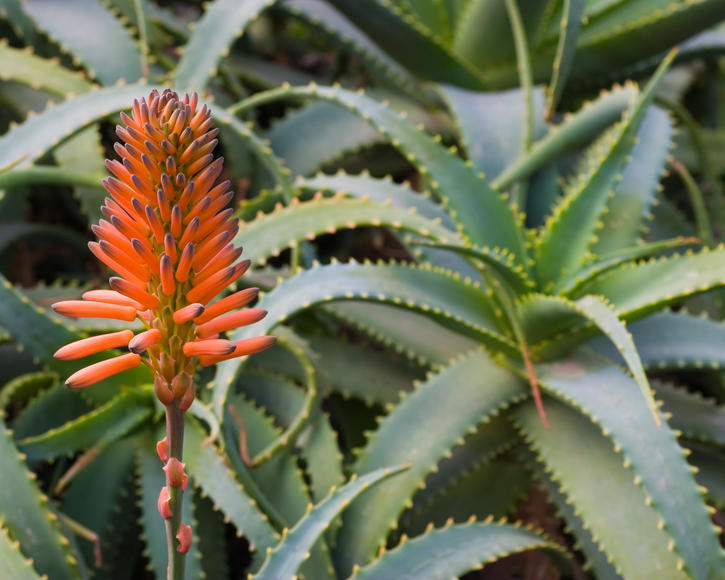Aloe Vera
True Aloe (Aloe vera) has a long tradition in treating skin injuries - however, it is also highly decorative as a potted plant. We introduce the interesting plant and provide care tips.
Factsheet
- Growth type
-
- Perennial plant
- Growth height (from)
- from 40 cm to 60 cm
- Growth width (from)
- from 40 cm to 60 cm
- Growth characteristics
-
- rosette-forming
- foothills
- thorns or spines
- Flower color
-
- yellow
- orange
- red
- Flowering time (month)
-
- January to February
- Flower shape
-
- tubular
- Cluster
- Leaf color
-
- green
- page format
-
- lancéolées
- pointed
- Light
-
- sunny
- Soil type
-
- gravelly to loamy
- Soil Moisture
-
- dry to moderately dry
- ph value
-
- alkaline to neutral
- Lime compatibility
-
- lime-loving
- Nutrient requirements
-
- moderately nutritious
- Humus
-
- low humus
- Decorative or utility value
-
- Flower Decoration
- Leaf ornaments
- medicinal plant
- Toxicity
-
- non-toxic
- Winter Hardness
-
- frost-sensitive
- Use
-
- Interior greening
- Planters
- Winter garden
- Garden style
-
- Pharmacy Garden
- Pot garden
The botanical genus name Aloe originates from the Arabic and means “bitter”, which is due to the bitter taste of the leaves. Vera is Latin and means ‘true’ or ‘real’. However, the plant is no bitter truth, because the roughly 250 species of the Aloe genus are assigned healing powers. The sap from the leaves has been used for skin care and as an effective medicine against skin diseases since the ancient times. The plant does indeed originate from the area of the Arabian peninsular, however over the centuries it has been exported to almost every country. Where it cannot thrive outdoors due to winter frosts, it is a welcome house or container plant.
Aloe vera is grass tree plant, even though its external appearance with fleshy, spikey leaves is more reminiscent of cacti or agaves. It is trunkless, grows in nutrient-rich soil, and forms leaves arranged in a rosette manner. As with all succulent plants, these are thick and fleshy. They grow to a point and have thorny leaf margins. The plants reach a height and diameter of up to 23.62 inches, depending on their location. In January, Aloe vera forms a long, stemmed inflorescence between the leaves. It grows straight upright and sometimes forms one to two side branches. Depending on the variety, it has yellow, red, or orange colored tubular flowers that are arranged in ring clusters around the stem.

In the German speaking world , written sources have referred to Aloe vera as a medicinal plant since the 12th century. As such, it has great significance even to this day, as does the candelabra aloe (Aloe arborescens): The leaf sap is primarily used for medicinal purposes, in particular to alleviate and heal skin diseases and injuries:
- It’s cleansing effect helps against acne and its calming affect against neurodermititis
- The sap of a freshly cut leaf cools minor burn injuries and promotes the healing process
- The sap also supports the healing of cuts and generally poorly healing wounds and abcesses
- In care products, Aloe vera reduces the formation of dandruff, strengthens hair roots and thereby combats hair loss
- The plant sap can also be used as a laxative if taken orally in the correct dosage
Note: While Aloe vera is prized as a medicinal plant, the lace aloe (Aloe aristata), spiral aloe (Aloe polyphylla), and tiger aloe (Aloe variegata) are among the poisonous members of the genus.

As Aloe vera originates from the tropics and sub-tropics, it loves warm locations in full sunlight. As a houseplant for direct sunlight, it needs a place next to a bright and sunny south-facing window or, even better, in a conservatory. The soil should contain minerals, be low in humus and nutrient-rich, but not too damp. Water permeable soil containing sand is ideal, as waterlogging often leads to rotting damage. Ready-made cactus or succulent soil is highly suitable for the plants.
True Aloe is usually cultivated as a container or houseplant. It can also be used together with various species of cacti and other tropical succulents to plant in troughs, but these must then be overwintered away from frost. You should certainly give it the sunniest and warmest place available in your home or on your patio in the summer.
Even though Aloe vera is cultivated as a houseplant, if should be placed on the balcony or patio in the summer, as the light conditions are significantly better here. Water the plant sparingly and make sure that the inside of the rosette is not damp. In its native home, the water supply in the rosette is often vital for survival, but in our regions it can lead to rotting damage. It’s best to water Aloe vera in its plant saucer and add some liquid cactus fertilizer to the water every two weeks. After the inflorescences have withered, cut them off to promote the formation of new flowers.

As a typical pot and container plant, Aloe vera must be repotted every two to four years, depending on its age. You should use sandy cactus or succulent soil for planting, alternatively, you can enrich potting soil with sand or clay granulate in a ratio of 2:1. You can also mix in a tablespoon full of calcium carbonate, as Aloe vera loves lime. After repotting, the plant must be supported with two wooden rods until it has formed new roots. Otherwise it may simply tip over in the new soil, as it is extremely heavy.
Move the Aloe to its winter residence in good time, as even temperatures of 39.2 degrees Fahrenheit can damage the plant. During the cold time of year it is best to move the Aloe vera to a bright, not too heavily heated conservatory at around 59 degrees Fahrenheit. Alternatively, a bright south-facing window in a cool room is also suitable. Water the plant very sparingly during the winter months - watering every four two six weeks is sufficient. Do not fertilize in the winter either. This rest phase is important for the plant to be able to form flowers. As soon as the flower shoots appear it can be put back in the warm.
If you want to propagate Aloe vera, it’s best to use the offsets. More precisely, Aloe vera forms plantlets and root offshoots. These small, ready-to-go plantlets can simply be separated from the mother plant in the spring and planted individually, provided they are at least 1.97 inches tall.
As long as no major care mistakes are made, Aloe vera is a highly robust plant that is hardly affected by pests or plant diseases. Plant failures can almost always be traced back to the incorrect substrate and too much watering. Mealy bugs sometimes appear in the winter months.

